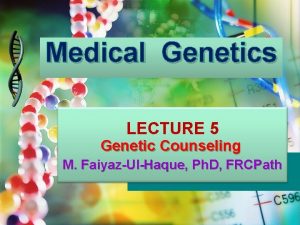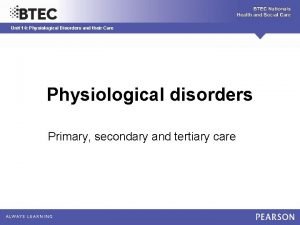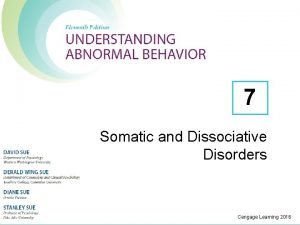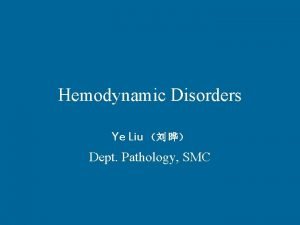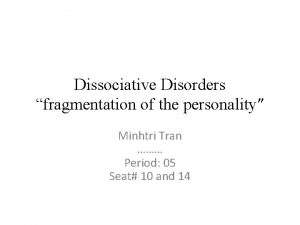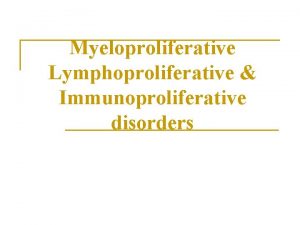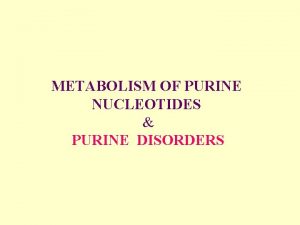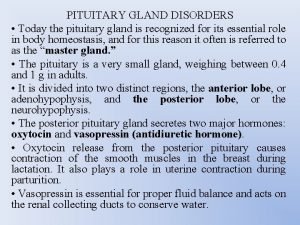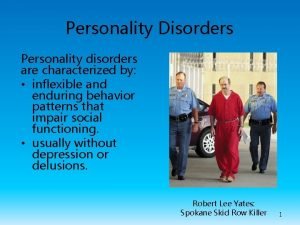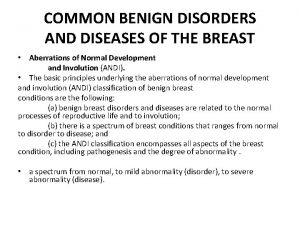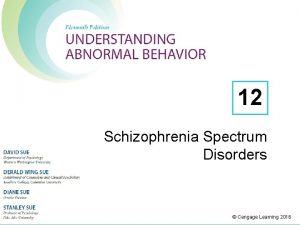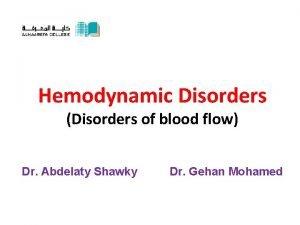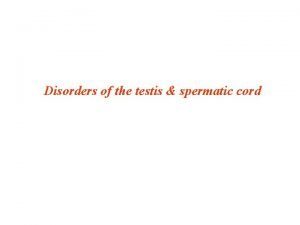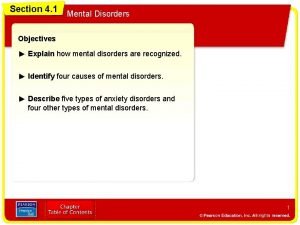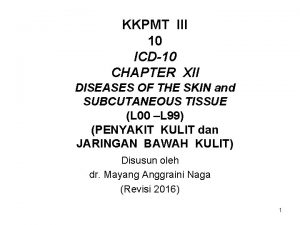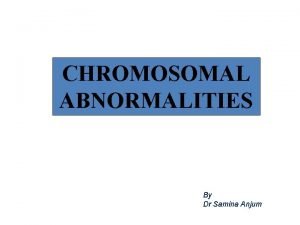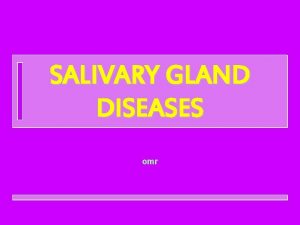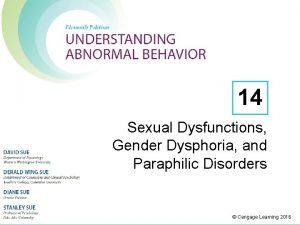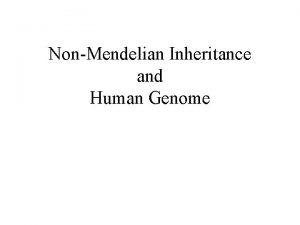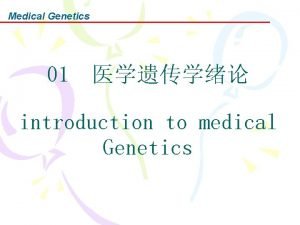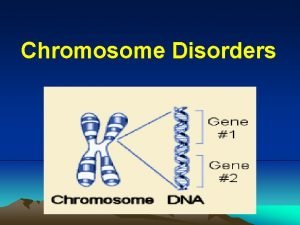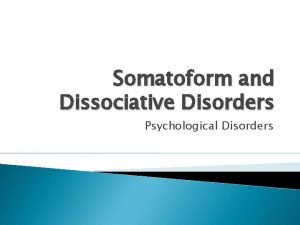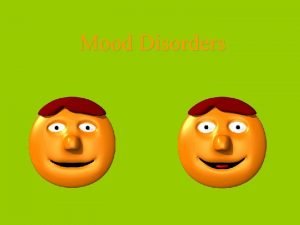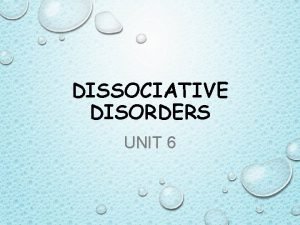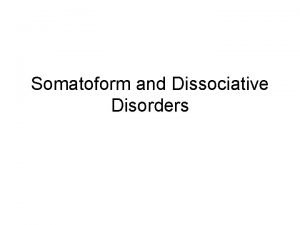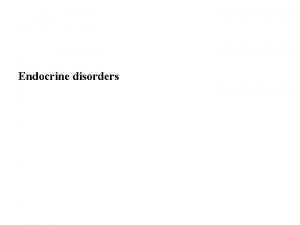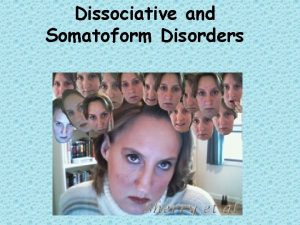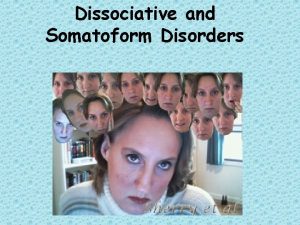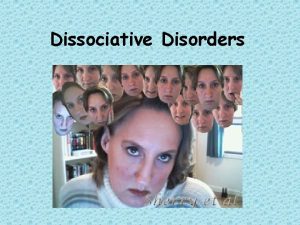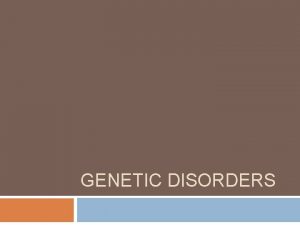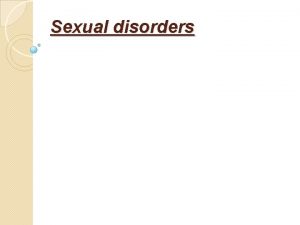Medical Genetics 12 Polygenetic disorders Medical Genetics Medical























































- Slides: 55

Medical Genetics 12 多基因遗传疾病 Polygenetic disorders

Medical Genetics

Medical Genetics 1. schizophrenia , SP Schizophrenia is a humorous brain disorder characterized by delusional thinking and unique but unpopular perceptions.

Medical Genetics Mental health professionals normally diagnose this illness if, during any onemonth period of a person’s life, that person has suffered two or more of the following: Delusions Hallucinations Disorganized speech Grossly disorganized or catatonic behavior Negative symptoms

Medical Genetics Negative symptoms are the most insidious behavioral effects of schizophrenia. They can include low levels of: Interest Motivation Emotional arousal Mental activity Social drive Speech

Medical Genetics Schizophrenia is equally represented in women and men. The onset of the illness generally occurs at a later age in women than in men (between ages 23 and 35 in women versus 18 to 25 for men). Not only do women generally present with schizophrenia at later ages, but the phenomenon of late onset schizophrenia (40+ years) is almost entirely a female one.

Medical Genetics

Medical Genetics Women tend to display more prominent mood symptoms and men more negative symptoms. In the first episode of schizophrenia, women are more likely to display intense irritability, anger, and sadness; men are more likely to be withdrawn and emotionally apathetic. After the first episode, these distinctions begin to blur. PMS is not an indication of the onset of schizophrenia in women, although the symptoms are strikingly similar.

Medical Genetics Subtypes of Schizophrenia 1. 2. 3. 4. 5. Disorganized Type Catatonic Type Paranoid Type Undifferentiated Type Residual Type

Medical Genetics Disorganized Type This subtype of schizophrenia is marked by significant regression to primitive, uninhibited, and disorganized behavior. Thumb-sucking, howling like a wolf, temper tantrums, creation of pornographic art and unreasonably strong cravings to suckle a female’s breast are characteristic of this type.

Medical Genetics Catatonic Type This subtype features gross psychomotor disturbances, i. e. , stupor, negativism, mutism, rigidity, excitement, prolonged erection, or posturing. Frequent fluctuation between these extreme physical states is common. Schizophrenics of this type can be the most fun for psychologists to play with. They can be posed like dolls, undressed while they’re catatonic and then left in a crowded bus station to regain psychomotor normality, or even substituted for psychiatrists in therapy sessions.

Medical Genetics Paranoid Type More often than not, this is a misdiagnosed condition of prominent delusions or auditory hallucinations of persecution or grandeur, accompanied by a relative preservation of cognitive functioning. In reality, these are functionally normal individuals who have discovered the fact that some other individual or organization is conspiring or acting to torture, murder, or financially disable them, but are unable to produce legitimate evidence supporting their suspicions.

Medical Genetics Undifferentiated Type This type was originally designed as a catch-all category for psychiatrists and psychologists too incompetent to diagnose a schizophrenic’s specific type. It is allegedly used when patients do not clearly fit into any one type, fit into more than one type, or do not fit into any of the other types. Psychiatrists tend to categorize schizophrenics as undifferentiated pending the discovery or creation of new mental disorders to label them with.

Medical Genetics Residual Type This type commonly displays emotional bluntness, social withdrawal, illogical thinking, eccentric behavior, or mild loosening of association. Elderly people suffering from Alzheimer’s disease, lepers, philosophers and Japanese males who have “lost face” are characteristic of this type.

Medical Genetics Causes of schizophrenia The cause of schizophrenia is unknown. Many mental health professionals believe there are factors which increase an individual’s risk of having schizophrenia.

Medical Genetics For example, first-degree biological relatives of persons with schizophrenia have a ten times greater risk of developing the illness than members of the general population. Also, in the United States, more schizophrenic patients are born in the winter months of January to April.

Medical Genetics

Medical Genetics

Medical Genetics Exhaustive scientific studies have revealed that mental health professionals who subscribe to this theory of causality also believe astrology is a legitimate scientific field.

Medical Genetics Because there is no cure for schizophrenia, the goal of treatment is to eliminate or reduce symptoms, minimize side effects, prevent relapse, and socially and occupationally rehabilitate the patient.

Medical Genetics This process can last a lifetime, or at least as long as a patient has available funds to pay for therapy. When funds are exhausted, mental health professionals generally begin advising their patients of the schizophrenic likelihood of suicide.

Medical Genetics

Medical Genetics

Medical Genetics

Medical Genetics

Medical Genetics 2. diabetes mellitus The term diabetes mellitus describes a metabolic disorder of multiple aetiology characterized by chronic hyperglycaemia with disturbances of carbohydrate, fat and protein metabolism resulting from defects in insulin secretion, insulin action, or both.

Medical Genetics

Medical Genetics

Medical Genetics The effects of diabetes mellitus include long-term damage, dysfunction and failure of various organs. Diabetes mellitus may present with characteristic symptoms such as thirst, polyuria, blurring of vision, and weight loss. In its most severe forms, ketoacidosis or a nonketotic hyperosmolar state may develop and lead to stupor, coma and, in absence of effective treatment, death.

Medical Genetics Often symptoms are not severe, or may be absent, and consequently hyperglycaemia sufficient to cause pathological and functional changes may be present for a long time before the diagnosis is made.

Medical Genetics The long-term effects of diabetes mellitus include progressive development of the specific complications of retinopathy with potential blindness, nephropathy that may lead to renal failure, and/or neuropathy with risk of foot ulcers, amputation, Charcot joints, and features of autonomic dysfunction, including sexual dysfunction. People with diabetes are at increased risk of cardiovascular, peripheral vascular and cerebrovascular disease.

Medical Genetics Several pathogenetic processes are involved in the development of diabetes. These include processes which destroy the beta cells of the pancreas with consequent insulin deficiency, and others that result in resistance to insulin action. The abnormalities of carbohydrate, fat and protein metabolism are due to deficient action of insulin on target tissues resulting from insensitivity or lack of insulin.

Medical Genetics Aetiological Classification of Disorders of Glycaemia • Type 1 : (beta-cell destruction, usually leading to absolute insulin deficiency) – Autoimmune – Idiopathic • Type 2 : (may range from predominantly insulin resistance with relative insulin deficiency to a predominantly secretory defect with or without insulin resistance) • Other specific types – – – – Genetic defects of beta-cell function Genetic defects in insulin action Diseases of the exocrine pancreas Endocrinopathies Drug- or chemical-induced Infections Uncommon forms of immune-mediated diabetes Other genetic syndromes sometimes associated with diabetes • Gestational diabetes

Medical Genetics Genetic defects Several forms of the diabetic state may be associated with monogenic defects in beta-cell function, frequently characterized by onset of mild hyperglycaemia at an early age (generally before age 25 years). They are usually inherited in an autosomal dominant pattern. Patients with these forms of diabetes, formerly referred to as maturity-onset diabetes of the young (MODY), have impaired insulin secretion with minimal or no defect in insulin action.

Medical Genetics Abnormalities at several genetic loci on different chromosomes have now been characterized.

Medical Genetics The most common form is associated with mutations on chromosome 12 in a hepatic nuclear transcription factor referred to as HNF 1 alpha.

Medical Genetics A second form is associated with mutations in the glucokinase gene on chromosome 7 p. Glucokinase converts glucose to glucose-6 -phosphate, the metabolism of which in turn stimulates insulin secretion by the beta cell.

Medical Genetics Thus, glucokinase serves as the "glucose sensor" for the beta cell. Because of defects in the glucokinase gene, increased levels of glucose are necessary to elicit normal levels of insulin secretion.

Medical Genetics A third form is associated with a mutation in the HNF 4 alpha gene on chromosome 20 q. HNF 4 alpha is a transcription factor which is involved in the regulation of the expression of HNF 1 alpha.

Medical Genetics A fourth variant has recently been ascribed to mutations in another transcription factor gene, IPF -1, which in its homozygous form leads to total pancreatic agenesis.

Medical Genetics Specific genetic defects in other individuals who have a similar clinical presentation are currently being defined.

Medical Genetics Point mutations in mitochondrial DNA have been found to be associated with diabetes mellitus and deafness. The most common mutation occurs at position 3243 in the t. RNA leucine gene, leading to an A to G substitution.

Medical Genetics An identical lesion occurs in the MELAS syndrome (Mitochondrial myopathy, Encephalopathy, Lactic Acidosis, and Stroke-like syndrome); however, diabetes is not part of this syndrome, suggesting for unknown reasons different phenotypic expressions of this genetic lesion.

Medical Genetics 3. bronchial asthma Bronchial asthma is the more correct name for the common form of asthma. The term bronchial asthma is used to differentiate it from cardiac asthma. Although the two types of asthma have similar symptoms, including shortness of breath and wheezing (a whistling sound in the chest), they have quite different causes.

Medical Genetics For most people with bronchial asthma, the pattern is periodic attacks of wheezing alternating with periods of quite normal breathing. However, some people with bronchial asthma alternate between chronic shortness of breath and episodes of even worse shortness of breath.

Medical Genetics Strong risks for developing bronchial asthma include being a person who is genetically susceptible to asthma and being exposed early in life to indoor allergens, such as dust mites and cockroaches, and having a family history of asthma or allergy.

Medical Genetics

Medical Genetics Bronchial asthma attacks can be triggered (precipitated or aggravated) by various factors, including: • respiratory tract infections; • cold weather; • exercise; • cigarette smoke and other air pollutants; • stress.

Medical Genetics In sensitive individuals, asthma symptoms can be triggered by inhaled allergens (allergy triggers), such as pet dander, dust mites, cockroach allergens, molds, or pollens. Asthma symptoms can also be triggered by respiratory infections, exercise, cold air, tobacco smoke and other pollutants, stress, food, or drug allergies.

Medical Genetics The symptoms of bronchial asthma include: • a feeling of tightness in the chest; • difficulty in breathing or shortness of breath; • wheezing; and • coughing (particularly at night).

Medical Genetics

Medical Genetics Asthma is found in 3 -5% of adults and 7 -10% of children. Half of the people with asthma develop it before age 10, and most develop it before age 30. Asthma symptoms can decrease over time, especially in children.

Medical Genetics Gene-environment interactions in the early life origins of asthma

Medical Genetics Genetic and Molecular Regulation of ADAM 33 was the first asthma susceptibility gene identified as a result of a genome-wide positional cloning effort. The identification of ADAM 33 as a major risk factor involved in the pathogenesis of bronchial hyper-responsiveness (BHR) and airway wall remodeling provides insight into the pathogenesis of asthma and represents a novel therapeutic target.

Medical Genetics The occurrence of ADAM 33 in embryonic mesenchymal cells suggests that it may be involved in airway wall "modeling" that contributes to the early life origins of asthma. We are conducting further studies into the genetic and molecular regulation of ADAM 33 including: • Characterisation of the ADAM 33 promoter • Correlation of ADAM 33 genotypes/haplotypes with molecular phenotypes • Association of ADAM 33 polymorphism with early-life lung function and COPD susceptibility • ADAM 33 -environment interactions and asthma susceptibility
 Polygenetic trait
Polygenetic trait Medical genetics lecture
Medical genetics lecture Apgar score
Apgar score Physiological disorders and their care
Physiological disorders and their care Lower limb disorders
Lower limb disorders Dissociative disorders
Dissociative disorders Dissociative
Dissociative Sleep disorders
Sleep disorders Chapter 17 somatic symptom disorders
Chapter 17 somatic symptom disorders Mnemonic for antisocial personality disorder
Mnemonic for antisocial personality disorder Hypothalamus eating disorders
Hypothalamus eating disorders Lines of zahn gross
Lines of zahn gross Derealization quotes
Derealization quotes Chapter 18 eating and feeding disorders
Chapter 18 eating and feeding disorders Immunoproliferative disorders examples
Immunoproliferative disorders examples Hirschsprung disease nursing management
Hirschsprung disease nursing management Somatoform disorders
Somatoform disorders Physiological disorders of strawberry
Physiological disorders of strawberry Purine disorders
Purine disorders Pituitary gland disorders
Pituitary gland disorders Eating disorders brainpop answers
Eating disorders brainpop answers Icd 10 anxietas
Icd 10 anxietas Inflexible personality
Inflexible personality What are physiological disorders health and social care
What are physiological disorders health and social care Neurodevelopmental disorders
Neurodevelopmental disorders Neurosis
Neurosis Puberty and autism spectrum disorders
Puberty and autism spectrum disorders Milady chapter 8 skin disorders and diseases
Milady chapter 8 skin disorders and diseases Andi in breast disease
Andi in breast disease Chapter 12 schizophrenia spectrum disorders
Chapter 12 schizophrenia spectrum disorders Unit 14 assignment 2 health and social care
Unit 14 assignment 2 health and social care Hemodynamic disorders
Hemodynamic disorders Weird wild wacky personality disorders
Weird wild wacky personality disorders Causes of paraphilic disorders
Causes of paraphilic disorders Secrotal
Secrotal Chapter 14 depressive disorders
Chapter 14 depressive disorders Section 4-1 mental disorders answers
Section 4-1 mental disorders answers Mnt for eating disorders
Mnt for eating disorders Autism authorization online program
Autism authorization online program Chapter 15 nervous system diseases and disorders
Chapter 15 nervous system diseases and disorders York eating disorders service
York eating disorders service Bipolar and other related disorders
Bipolar and other related disorders Cluster b personality disorders
Cluster b personality disorders Who analgesic ladder
Who analgesic ladder Chapter 21 mental health diseases and disorders
Chapter 21 mental health diseases and disorders Hypertrophic disorders of skin adalah
Hypertrophic disorders of skin adalah Axis 1 and axis 2 disorders
Axis 1 and axis 2 disorders Chromosome 13 abnormality
Chromosome 13 abnormality Ap psychology chapter 15 psychological disorders
Ap psychology chapter 15 psychological disorders Chapter 6 musculoskeletal system diseases and disorders
Chapter 6 musculoskeletal system diseases and disorders Salivary gland disease classification
Salivary gland disease classification Looney tunes speech impediments
Looney tunes speech impediments Attachment issues
Attachment issues Paraphilic
Paraphilic The uk national disorders
The uk national disorders Gross
Gross

